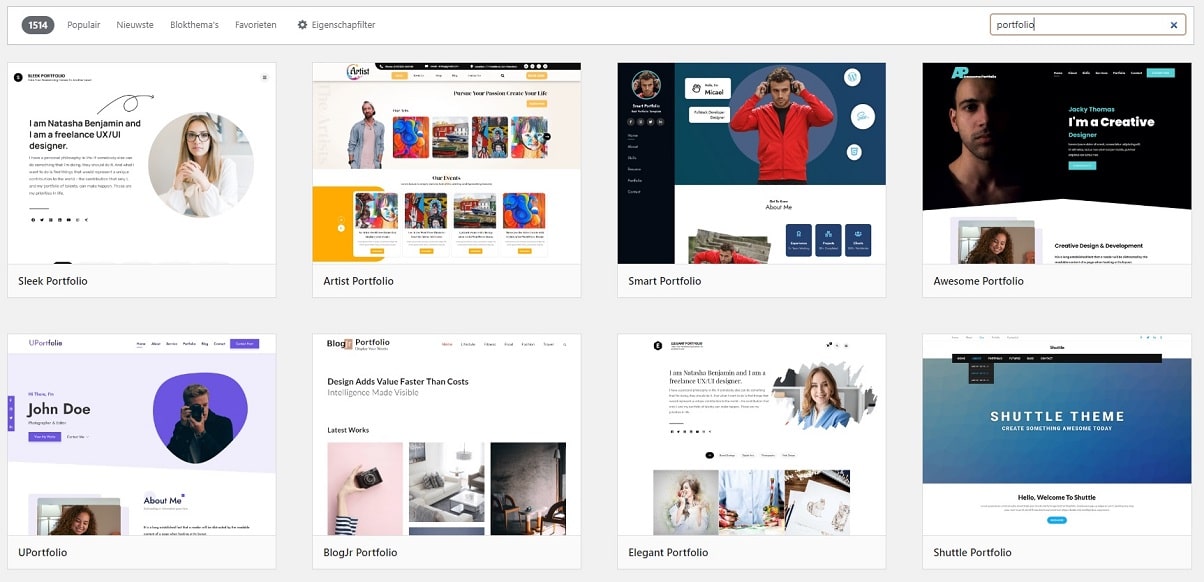What should be on a portfolio website?
Many freelancers have a portfolio website or will create one as soon as they have taken the first steps, such as registering the domain name and package. Then you can ask yourself what should be on your portfolio website and how to build it. In this blog post, we'll take a closer look and explain!
Creating a portfolio website with WordPress
WordPress is the most widely used method of creating websites in the world because it's user-friendly and suitable for beginners. If you read up a little, you can achieve a great result within an afternoon. Finally, there are thousands of free themes for WordPress that can be installed on your website with one click and that you can then customize to your liking in a visual way, i.e. without coding. WordPress itself is also installed with 1 click in the hosting of MijnHostingPartner.nl. In our knowledge base, we have plenty of articles to help you get started.
Your chance to present your work creatively
An online portfolio is an opportunity to showcase your work. No matter what exactly you offer as a service, there's always a way to showcase it in a portfolio. Think about the last photos you took as a photographer, the last kitchen knives you made or the last dinners you hosted as a private chef. You can always demonstrate your work and present it in a visual way. Even if your profession itself is not visual.
You can do this by showing images on your website, videos or interesting diagrams. All of this is possible within WordPress, and without installing any extras. Is this not what you want to see on your website? Then you can always install a plug-in in WordPress to make this possible. Finally, it's very difficult to have another unique issue, especially within WordPress.
Show testimonials from customers
Testimonials is an English term for customer reviews and experiences. This helps to show potential customers that you're not just selling hot air. And that customers are also satisfied with your work. Of course, it is logical not to show negative experiences here; you can control this within your website. Outside the website, this is more difficult to influence. Take a nice picture of the project you delivered and put the customer next to it with a quote of the experience. In return, you can include a link to the client's work or website.
About me
As well as showcasing your work, it's also important to introduce yourself on your portfolio website. Add a page where you tell more about who you are, what your passions are and what drives you as a freelancer. Potential clients often want to be able to put a face to the work they see. This can lead to a closer bond than an anonymous interaction and therefore a higher likelihood that they will work with you again.
Services and specializations
List the services you offer and highlight your specializations. This will give visitors a clear idea of what you have to offer and what you excel at. This can help them make decisions and assess whether you are the right freelancer for their project.
Contact information and call-to-action
Make sure your contact information is easy to find on your portfolio website. Add a separate page with your email address, phone number and links to your social media if applicable. A clear call-to-action encourages visitors to contact you for a possible collaboration.
Here you can also decide whether you want to display a pop-up window with an invitation to talk after a certain time on your website. However, this can also be perceived as annoyingly fast. So always try to be careful with this.
Blog section
A blog section can be valuable for showcasing your expertise and engaging with potential customers. Write articles about trends in your field, share tips and tricks or provide insights into your work process. This will not only showcase your knowledge, but also improve the search engine optimization (SEO) of your website. Blogging is often also a creative outlet and offers the opportunity to demonstrate your knowledge in a less formal and direct way. If you do this with some regularity, you also send out a positive signal and are more likely to appear for larger topics in the various search engines.
In addition, blogs are a good way to naturally fill your website with more content, if visitors who are not yet convinced continue to look for more reading material, blogs can be the way to turn a visitor into a customer. Blogs can also be a great way to turn them into posts for social media. These can offer more than just another offer or another generic post.
Responsive design
Make sure your portfolio website is accessible on different devices, such as smartphones and tablets. A responsive design improves the user experience and ensures that your potential customers can easily navigate through your website, no matter what device they are using. Most WordPress themes already take this into account. However, test for yourself whether your entire website is responsive on mobile devices and tablets.
Call-to-action buttons
Add call-to-action buttons in strategic places, e.g. "Contact us" or "Request a quote". This makes it easier for visitors to take the next step and actually get in touch with you.
Maintenance and updating
A portfolio website is not a static thing. Make sure you regularly update your portfolio with new projects and experiences. This shows that you are active and engaged in your field, which can convince potential clients of your professionalism.
With these additions, you make your portfolio website even more complete and attractive to potential clients. Also ensure the right foundation for your portfolio with hosting from MijnHostingPartner.nl Good luck with building your online business card!
